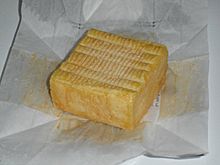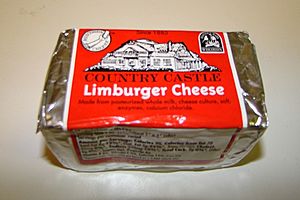Limburger facts for kids
Quick facts for kids Limburger |
|
|---|---|
 |
|
| Country of origin | The Low Countries and Germany |
| Source of milk | Cow |
| Texture | Semi-soft |
| Aging time | 2–3 months |
| Named after | Lua error in Module:Wikidata at line 70: attempt to index field 'wikibase' (a nil value). |
| Herve | |
|---|---|
 |
|
| Other names | Fromage de Herve |
| Country of origin | Belgium |
| Region | Pays de Herve |
| Town | Herve |
| Source of milk | Cow |
| Texture | Soft |
| Fat content | 45% |
| Weight | 50, 100, 200, or 400 g |
| Aging time | 3 weeks to 2 months |
| Certification | PDO |
Limburger is a type of cheese famous for its very strong smell. It first came from the Herve area in what used to be the Duchy of Limburg. This area is now part of Belgium. The strong smell of Limburger cheese comes from a special kind of bacterium called Brevibacterium linens.
In Belgium, this cheese is often called Herve cheese or Rommedoe. People have been making Herve cheese since the 1400s!
Contents
History and Where Limburger Cheese Comes From
The name "Herve" is now a special protected name in Europe for this cheese. This means only cheese made in the Herve region of Belgium can be called Herve. But the name "Limburger" is used for the same style of cheese when it's made in other places.
Herve cheese is still made in the area of the old Duchy of Limburg in Belgium. This region is close to Liège and the borders of the Netherlands and Germany. The "Land of Herve" is a hilly area between the Vesdre and Meuse rivers. The Duchy of Limburg was part of the Holy Roman Empire until the French Revolution. Because of this, the cheese style became popular in other areas, taking the name of its original country.
In the United States, Limburger cheese was first made in 1854. This happened at the F.X. Baumert cheese factory in Antwerp, New York. Later, in 1867, Rudolph Benkerts started making it in his cellar. Soon, many factories were making this cheese. Today, the Chalet Cheese Cooperative in Monroe, Wisconsin, is the only American company that still makes it. Limburger is also made in Canada by the Oak Grove Cheese Company. It is a special food for German-Canadian communities there.
How Limburger Cheese is Made
Herve is a Belgian washed-rind soft cheese. It is made from raw cow's milk. The cheese gets its special flavor and texture during an aging process. This aging happens in cool cellars in the Herve countryside. Some of these cellars are even cut into the chalky rock!
Sometimes, people add herbs to flavor the cheese. Herve cheese has a light yellow inside. It also has a shiny reddish-brown coating. This coating is created by the bacteria that grow on the cheese during its 3-month aging time. Limburger cheese is usually shaped like a brick when it is sold. The taste and flavor of the cheese get stronger as it ages. When it is young, the cheese tastes sweet. As it gets older, it becomes more spicy.
What Limburger Cheese is Like
When Limburger cheese is only about a month old, it is firmer. It can also be a bit crumbly, like feta cheese. After about six weeks, the edges of the cheese become softer. But the middle part is still firm. At this stage, it can taste salty and a bit chalky.
After two months, the cheese becomes mostly creamy and much smoother. Once it reaches three months, the cheese develops its famous strong smell. This smell comes from the bacterium Brevibacterium linens. This is the same type of bacterium found on human skin that causes body odor, especially foot odor.
Ways to Enjoy Limburger Cheese
Limburger is considered one of the most popular cheeses in Belgium.
One common way to eat Limburger is in a sandwich. After three months of aging, the cheese becomes soft enough to spread. People often spread a thick layer (more than 0.5 cm or 0.2 inch) of cheese on firm rye bread. They add a large, thick slice of onion. This sandwich is usually eaten with strong black coffee or lager beer. You can also cut thick chunks or slices of the cheese for the sandwich.
This sandwich is still very popular among the descendants of Swiss and German immigrants in the Midwestern United States. Places like Wisconsin and Ohio are known for it. In the early 1900s, Limburger sandwiches were a popular lunch for workers. They were cheap and healthy. People often ate them with a glass of beer.
However, the sandwich is less popular with younger generations born after 1960. This is mainly because of its very strong smell. Also, it can be hard to find, as you often need to go to special cheese shops to buy it.
In Wisconsin, some restaurants still have the Limburger sandwich on their menus. It is often served with brown mustard. There are different ways to make it. Some people add bologna, lettuce, tomato, or roasted walnuts. Others use white or French bread instead of rye. Sometimes, people rinse or remove the cheese rind to make the smell less strong.
Limburger Cheese in Pop Culture
Limburger cheese and its unique smell are often used for jokes. The smell of Limburger cheese has been a funny part of many cartoons and movies. You can see reactions to it in Looney Tunes, Little Rascals, and The Three Stooges comedy shorts. It was also a gag in the 1942 Abbott and Costello film Who Done It?. Also, the main bad guy in Biker Mice from Mars is named Lawrence Limburger. He is known for his terrible body odor.
The smell of the cheese is also mentioned in a song. In 1979, the band the B-52's released the song "Dance This Mess Around". One line says, "why don't you dance with me? I'm not no Limburger." This suggests the singer feels she might not get a dancing partner because of a bad smell.
In the Disney Channel Original Movie Don't Look Under the Bed, a character named Larry makes "Boogey Goo." This goo is supposed to smell awful. Limburger Cheese is listed as one of its ingredients.
A scientific study about Limburger cheese even won an Ig Nobel Prize in 2006. This prize is given for funny or unusual scientific research. The study showed that the malaria mosquito (Anopheles gambiae) is attracted to the smell of Limburger cheese. It is attracted just as much as it is to the smell of human feet! The results of this study were published in a medical journal in 1996. Because of these findings, scientists have used traps with Limburger cheese in parts of Africa. This helps them fight the spread of malaria.
Nutrition Facts
Here's what 100 grams of Limburger cheese contains:
- 17 g of saturated fat and 27 g of total fat
- 327 calories, with 240 calories coming from fat
- 90 mg of cholesterol
- 800 mg of sodium
- 20 g of protein
See also
 In Spanish: Limburger para niños
In Spanish: Limburger para niños


